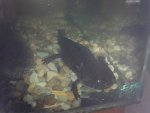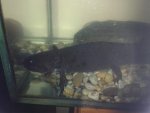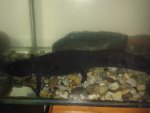SharonNZ
New member
- Joined
- Dec 19, 2015
- Messages
- 12
- Reaction score
- 0
- Points
- 0
- Location
- Rotorua, New Zealand
- Country
- New Zealand
Hi. I'm a new member. I joined as I took on an 11 year old, 25cm unwanted Axolotl. When he arrived his tank was in a disgusting state. He didn't have a name so have called him Gonzales.
I have never owned one before and know nothing about them. He came with stones that are small enough to eat but too big to pass. I have researched online to try and learn to give him the best life possible and have seen that sand should be used? I am from Rotorua, NZ, and I don't think the local pet shop people really know much about them as their's are on the same stones and said that they can be on stones not sand or tiny stones. As there was nothing but stones in the tank I asked should he have something for him to hide in etc and was told they don't need anything. Is that correct? Lastly but most importantly, he just spat out all of the food he came with, which is a square meat called Axolotl tucker. So I bought Axolotl pellets and he is not eating those. The pet shop said that if he has swallowed a stone his mouth would be open and it isn't. He looks fine so would you have any idea why he may not be eating.
I have never owned one before and know nothing about them. He came with stones that are small enough to eat but too big to pass. I have researched online to try and learn to give him the best life possible and have seen that sand should be used? I am from Rotorua, NZ, and I don't think the local pet shop people really know much about them as their's are on the same stones and said that they can be on stones not sand or tiny stones. As there was nothing but stones in the tank I asked should he have something for him to hide in etc and was told they don't need anything. Is that correct? Lastly but most importantly, he just spat out all of the food he came with, which is a square meat called Axolotl tucker. So I bought Axolotl pellets and he is not eating those. The pet shop said that if he has swallowed a stone his mouth would be open and it isn't. He looks fine so would you have any idea why he may not be eating.



